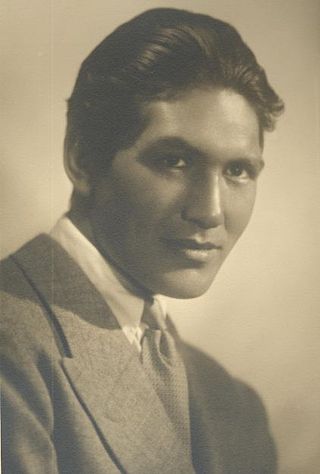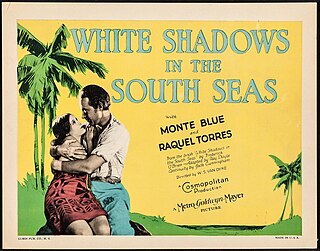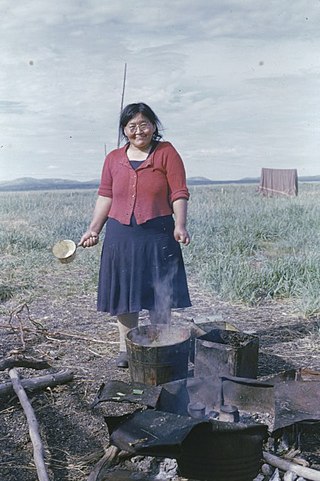Eskimo is an exonym that refers to two closely related Indigenous peoples: Inuit and the Yupik of eastern Siberia and Alaska. A related third group, the Aleut, who inhabit the Aleutian Islands, are generally excluded from the definition of Eskimo. The three groups share a relatively recent common ancestor, and speak related languages belonging to the family of Eskaleut languages.

Utqiagvik, formerly known as Barrow, is the borough seat and largest city of the North Slope Borough in the U.S. state of Alaska. Located north of the Arctic Circle, it is one of the northernmost cities and towns in the world and the northernmost in the United States, with nearby Point Barrow as the country's northernmost point.

The Inupiat are a group of Alaska Natives whose traditional territory roughly spans northeast from Norton Sound on the Bering Sea to the northernmost part of the Canada–United States border. Their current communities include 34 villages across Iñupiat Nunaat, including seven Alaskan villages in the North Slope Borough, affiliated with the Arctic Slope Regional Corporation; eleven villages in Northwest Arctic Borough; and sixteen villages affiliated with the Bering Straits Regional Corporation. They often claim to be the first people of the Kauwerak.

Woodbridge Strong Van Dyke II was an American film director who made several successful early sound films, including Tarzan the Ape Man in 1932, The Thin Man in 1934, San Francisco in 1936, and six popular musicals with Nelson Eddy and Jeanette MacDonald. He received two Academy Award nominations for Best Director for The Thin Man and San Francisco, and directed four actors to Oscar nominations: William Powell, Spencer Tracy, Norma Shearer, and Robert Morley. Known as a reliable craftsman who made his films on schedule and under budget, he earned the name "One Take Woody" for his quick and efficient style of filming.
John Lee Mahin was an American screenwriter and producer of films who was active in Hollywood from the 1930s to the 1960s. He was known as the favorite writer of Clark Gable and Victor Fleming. In the words of one profile, he had "a flair for rousing adventure material, and at the same time he wrote some of the raciest and most sophisticated sexual comedies of that period."

The umiak, umialak, umiaq, umiac, oomiac, oomiak, ongiuk, or anyak is a type of open skin boat, used by the Yupik and Inuit, and was originally found in all coastal areas from Siberia to Greenland. First used in Thule times, it has traditionally been used in summer, for moving people and possessions to seasonal hunting grounds, and for hunting whales and walrus. Although the umiak was usually propelled by oars (women) or paddles (men), sails—sometimes made from seal intestines—were also used, and, in the 20th century, outboard motors. Because the umiak has no keel, the sails cannot be used for tacking.

Prehistoric Alaska begins with Paleolithic people moving into northwestern North America sometime between 40,000 and 15,000 years ago across the Bering Land Bridge in western Alaska; a date less than 20,000 years ago is most likely. They found their passage blocked by a huge sheet of ice until a temporary recession in the Wisconsin glaciation opened up an ice-free corridor through northwestern Canada, possibly allowing bands to fan out throughout the rest of the continent. Eventually, Alaska became populated by the Inuit and a variety of Native American groups. Trade with both Asia and southern tribes was active even before the advent of Europeans.

Tarzan and His Mate is a 1934 American pre-Code action adventure film based on the Tarzan character created by Edgar Rice Burroughs. Directed by Cedric Gibbons, it was the second in the Tarzan film series and starred Johnny Weissmuller and Maureen O'Sullivan. In 2003, the United States Library of Congress deemed the film "culturally, historically or aesthetically significant" and selected it for preservation in the National Film Registry.

Lorenz Peter Elfred Freuchen was a Danish explorer, author, journalist and anthropologist. He is notable for his role in Arctic exploration, namely the Thule Expeditions.

Ray Mala was a prominent Alaska Native actor. He was one of Hollywood's Native American movie actors along with Lillian St. Cyr, Jesse Cornplanter, Chief Yowlachie, William Eagle Shirt, and Will Rogers who also had successful careers during that time. Mala's career peaked in the 1930s and he was best known for his lead role in Republic Pictures' 14-part serial Robinson Crusoe of Clipper Island (1936) following his feature role in MGM's Eskimo, directed by Woody Van Dyke. He was named a "Top Ten Alaskan" by TIME Magazine in 2009.

The Northern or Northwestern is a genre in various arts that tell stories set primarily in the late 19th or early 20th century in the north of North America, primarily in western Canada but also in Alaska. It is similar to the Western genre, but many elements are different, as appropriate to its setting. It is common for the central character to be a Mountie instead of a cowboy or sheriff. Other common characters include fur trappers and traders, lumberjacks, prospectors, First Nations people, outlaws, settlers, and townsfolk.

Traditional Alaskan Native religion involves mediation between people and spirits, souls, and other immortal beings. Such beliefs and practices were once widespread among Inuit, Yupik, Aleut, and Northwest Coastal Indian cultures, but today are less common. They were already in decline among many groups when the first major ethnological research was done. For example, at the end of the 19th century, Sagdloq, the last medicine man among what were then called in English, "Polar Eskimos", died; he was believed to be able to travel to the sky and under the sea, and was also known for using ventriloquism and sleight-of-hand.

Hunt Stromberg was a film producer during Hollywood's Golden Age. In a prolific 30-year career beginning in 1921, Stromberg produced, wrote, and directed some of Hollywood's most profitable and enduring films, including The Thin Man series, the Nelson Eddy/Jeanette MacDonald operettas, The Women, and The Great Ziegfeld, which won the Academy Award for Best Picture of 1936.

The Nunamiut or Nunatamiut are semi-nomadic inland Iñupiat located in the northern and northwestern Alaskan interior, mostly around Anaktuvuk Pass, Alaska.

Inuit are a group of culturally and historically similar Indigenous peoples traditionally inhabiting the Arctic and subarctic regions of North America, including Greenland, Labrador, Quebec, Nunavut, the Northwest Territories, Yukon (traditionally), Alaska, and Chukotsky District of Chukotka Autonomous Okrug, Russia. Inuit languages are part of the Eskimo–Aleut languages, also known as Inuit-Yupik-Unangan, and also as Eskaleut. Inuit Sign Language is a critically endangered language isolate used in Nunavut.

White Shadows in the South Seas is a 1928 American synchronized sound romantic adventure film directed by W.S. Van Dyke and starring Monte Blue and Raquel Torres. It was produced by Cosmopolitan Productions in association with MGM and distributed by MGM. While the film has no audible dialog, it was released with a synchronized musical score with sound effects using the sound-on-film Western Electric Sound System process. Loosely based on the travel book of the same name by Frederick O'Brien, this film is important historically for being the first sound MGM film to be released with a pre-recorded soundtrack. Clyde De Vinna won an Academy Award for Best Cinematography.

Subsistence hunting of the bowhead whale is permitted by the International Whaling Commission, under limited conditions. While whaling is banned in most parts of the world, some of the Native peoples of North America, including the Inuit and Iñupiat peoples in Alaska, continue to hunt the Bowhead whale. Aboriginal whaling is valued for its contribution to food stocks and to cultural survival, although the days of commercial whaling in the United States and in Canada are over.

Della Keats (Putyuk) was an Inupiaq healer and midwife who grew up and came of age in the Northwest Arctic region of Alaska during the first half of the 20th century. Further inland from the coast, the region she inhabited is in the drainage areas of the Noatak, Kobuk, and Selawik Rivers as well as Sisualik. Her life in this region coincided with rapid changes as other peoples voyaged and then settled in alongside indigenous societies. Over the latter half of the 19th century, increased contact helped to spread disease; local people acquired firearms and alcohol; and some inhabitants abandoned their traditional territories by the turn of the century. Missions and schools were established in 1905-1915. During this time, families alternated between school and subsistence seasons. It was not until after the 1930s that Inupiat settled more permanently into villages. This was a time of rapid shifts, and Della Keats and her family lived a traditional subsistence lifestyle while gradually incorporating new materials and entering into trade with a cash economy. She was a tribal member of one of the ten communities in the Kotzebue region, Nautaaq (Noatak).
The Barrow Duck-In was a civil disobedience event that occurred in Utqiaġvik, Alaska, in the spring of 1961. During the Duck-in, the Iñupiat protested a federal hunting ban on ducks, which threatened their livelihood and rights to food security. The Alaskan North Slope is a remote and rural area, and many residents rely on seasonal bird hunts for sustenance. A series of attempts to regulate Iñupiat subsistence by federal and international entities led to the Duck-in, in which over one-hundred Iñupiaq residents of Utqiaġvik protested waterfowl regulations in the area. The Duck-in is considered a seminal protest, as it had significant influence over future subsistence regulation and Native claims laws in Alaska, such as the Alaska Native Claims Settlement Act (ANCSA).
The Nanuk was a trading and whaling schooner, which was later used in the Hollywood film industry as a historicising full-rigged ship for movies, among other things.



















